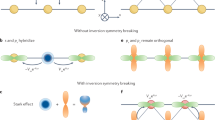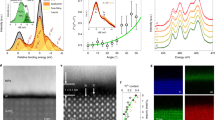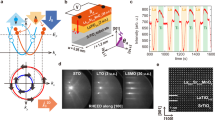Abstract
The spin–orbit interaction plays an important role in magnetism and in many quantum materials. It is the cornerstone of the physics of many electronic phases that emerge at interfaces because of broken inversion symmetry. In that context, the spin Rashba effect locks electronic spins with momentum to produce large spin galvanic effects. It has recently been argued that these spin-based effects could in fact be spin–orbit coupling consequences of a potentially larger orbital effect. Here we observe spin-to-charge conversion at a LaAlO3/SrTiO3 interface and demonstrate that its orbital contribution dominates. Our analysis of the in-plane anisotropy and gate voltage dependence of the angular momentum conversion into charge highlights some of the salient features of the orbital Rashba splitting. These results open the door to broader use of pure orbital angular momentum effects and confirm the potential of the orbital degree of freedom for information storage and processing.
This is a preview of subscription content, access via your institution
Access options
Access Nature and 54 other Nature Portfolio journals
Get Nature+, our best-value online-access subscription
$29.99 / 30 days
cancel any time
Subscribe to this journal
Receive 12 print issues and online access
$209.00 per year
only $17.42 per issue
Buy this article
- Purchase on Springer Link
- Instant access to full article PDF
Prices may be subject to local taxes which are calculated during checkout




Similar content being viewed by others
Data availability
The data that support the findings of this study are available via Zenodo at https://zenodo.org/deposit/7958054. Source data are provided with this paper.
Code availability
The codes that support the findings of the study are available from the corresponding author on reasonable request. Quantum ESPRESSO is available at https://www.quantum-espresso.org/.
References
Edelstein, V. M. Spin polarization of conduction electrons induced by electric current in two-dimensional asymmetric electron systems. Solid State Commun. 73, 233–235 (1990).
Bhattacharjee, S., Singh, S., Wang, D., Viret, M. & Bellaiche, L. Prediction of novel interface-driven spintronic effects. J. Phys. Condens. Matter 26, 315008 (2014).
Winkler, R. Spin–Orbit Coupling Effects in Two-Dimensional Electron and Hole Systems (Springer, 2003).
Gorini, C., Schwab, P., Dzierzawa, M. & Raimondi, R. Spin polarizations and spin Hall currents in a two-dimensional electron gas with magnetic impurities. Phys. Rev. B 78, 125327 (2008).
Ganichev, S. D. et al. Spin-galvanic effect. Nature 417, 153–156 (2002).
Gorini, C. et al. Theory of current-induced spin polarization in an electron gas. Phys. Rev. B 95, 205424 (2017).
Ganichev, S. D., Trushin, M. & Schliemann, J. in Spintronics Handbook: Spin Transport and Magnetism 2nd edn, Vol. 2 Ch. 7 (CRC Press, 2019).
Rojas-Sánchez, J.-C. et al. Spin-to-charge conversion using Rashba coupling at the interface between non-magnetic materials. Nat. Comm. 4, 2944 (2013).
Shen, K., Vignale, G. & Raimondi, R. Microscopic theory of the inverse Edelstein effect. Phys. Rev. Lett. 112, 096601 (2014).
Ivchenko, E. L. & Ganichev, S. D. Spin-dependent photogalvanic effects (A review). Preprint at https://arxiv.org/abs/1710.09223 (2017).
Park, S. R., Kim, C. H., Yu, J., Han, J. H. & Kim, C. Orbital-angular-momentum based origin of Rashba-type surface band splitting. Phys. Rev. Lett. 107, 156803 (2011).
Park, J.-H., Kim, C. H., Rhim, J.-W. & Han, J. H. Orbital Rashba effect and its detection by circular dichroism angle-resolved photoemission spectroscopy. Phys. Rev. B 85, 195401 (2012).
Levitov, L. S., Nazarov, Y. V. & Eliashberg, G. M. Magnetoelectric effects in conductors with mirror isomer symmetry. Zh. Eksp. Teor. Fiz. 88, 229–236 (1985).
Kim, Y., Lutchyn, R. M. & Nayak, C. Origin and transport signatures of spin-orbit interactions in one- and two-dimensional SrTiO3-based heterostructures. Phys. Rev. B 87, 245121 (2013).
Go, D. et al. Theory of current-induced angular momentum transfer dynamics in spin-orbit coupled systems. Phys. Rev. Res. 2, 033401 (2020).
Ding, S. et al. Harnessing orbital-to-spin conversion of interfacial orbital currents for efficient spin-orbit torques. Phys. Rev. Lett. 125, 177201 (2020).
Lee, S. et al. Efficient conversion of orbital Hall current to spin current for spin-orbit torque switching. Commun. Phys. 4, 234 (2021).
Ohtomo, A. & Hwang, H. Y. A high-mobility electron gas at the LaAlO3/SrTiO3 heterointerface. Nature 427, 423–426 (2004).
Reyren, N. et al. Superconducting interfaces between insulating oxides. Science 317, 1196–1199 (2007).
Caviglia, A. D. et al. Electric field control of the LaAlO3/SrTiO3 interface ground state. Nature 456, 624–627 (2008).
Ben Shalom, M. et al. Anisotropic magnetotransport at the SrTiO3/LaAlO3 interface. Phys. Rev. B 80, 140403 (2009).
Caviglia, A. D. et al. Tunable Rashba spin-orbit interaction at oxide interfaces. Phys. Rev. Lett. 104, 126803 (2010).
Zhong, Z., Tóth, A. & Held, K. Theory of spin-orbit coupling at LaAlO3/SrTiO3 interfaces and SrTiO3 surfaces. Phys. Rev. B 87, 161102 (2013).
King, P. D. C. et al. Quasiparticle dynamics and spin–orbital texture of the SrTiO3 two-dimensional electron gas. Nat. Commun. 5, 3414 (2014).
Fête, A., Gariglio, S., Caviglia, A. D., Triscone, J.-M. & Gabay, M. Rashba induced magnetoconductance oscillations in the LaAlO3-SrTiO3 heterostructure. Phys. Rev. B 86, 201105 (2012).
Vaz, D. C. et al. Mapping spin–charge conversion to the band structure in a topological oxide two-dimensional electron gas. Nat. Mater. 18, 1187–1193 (2019).
Vivek, M., Goerbig, M. O. & Gabay, M. Topological states at the (001) surface of SrTiO3. Phys. Rev. B 95, 165117 (2017).
Joshua, A., Ruhman, J., Pecker, S., Altman, E. & Ilani, S. Gate-tunable polarized phase of two-dimensional electrons at the LaAlO3/SrTiO3 interface. Proc. Natl Acad. Sci. USA 110, 9633–9638 (2013).
Lesne, E. et al. Highly efficient and tunable spin-to-charge conversion through Rashba coupling at oxide interfaces. Nat. Mater. 15, 1261–1266 (2016).
Chauleau, J.-Y. et al. Efficient spin-to-charge conversion in the 2D electron liquid at the LAO/STO interface. Europhys. Lett. 116, 17006 (2016).
Johansson, A., Göbel, B., Henk, J., Bibes, M. & Mertig, I. Spin and orbital Edelstein effects in a two-dimensional electron gas: theory and application to SrTiO3 interfaces. Phys. Rev. Res. 3, 013275 (2021).
To, D. Q. et al. Spin to charge conversion at Rashba-split SrTiO3 interfaces from resonant tunneling. Phys. Rev. Res. 3, 043170 (2021).
Richter, C. et al. Interface superconductor with gap behaviour like a high-temperature superconductor. Nature 502, 528–531 (2013).
Gariglio, S., Gabay, M. & Triscone, J.-M. Research update: conductivity and beyond at the LaAlO3/SrTiO3 interface. APL Mater. 4, 060701 (2016).
Park, J.-H., Kim, C. H., Lee, H.-W. & Han, J. H. Orbital chirality and Rashba interaction in magnetic bands. Phys. Rev. B 87, 041301 (2013).
Jo, D., Go, D. & Lee, H.-W. Gigantic intrinsic orbital Hall effects in weakly spin-orbit coupled metals. Phys. Rev. B 98, 214405 (2018).
Lee, D. et al. Orbital torque in magnetic bilayers. Nat. Commun. 12, 6710 (2021).
Go, D. et al. Long-range orbital magnetoelectric torque in ferromagnets (2022); https://arxiv.org/abs/2106.07928
Reyren, N. et al. Gate-controlled spin injection at LaAlO3/SrTiO3 interfaces. Phys. Rev. Lett. 108, 186802 (2012).
Tserkovnyak, Y., Brataas, A. & Bauer, G. E. W. Enhanced Gilbert damping in thin ferromagnetic films. Phys. Rev. Lett. 88, 117601 (2002).
Uchida, K. et al. Observation of the spin Seebeck effect. Nature 455, 778–781 (2008).
Adachi, H., Uchida, K., Saitoh, E. & Maekawa, S. Theory of the spin Seebeck effect. Rep. Prog. Phys. 76, 036501 (2013).
Rousseau, O. et al. Spin-charge conversion in ferromagnetic Rashba states. Phys. Rev. B 104, 134438 (2021).
Shanavas, K. V. Theoretical study of the cubic Rashba effect at the SrTiO3 (001) surfaces. Phys. Rev. B 93, 045108 (2016).
Zhou, J., Shan, W.-Y. & Xiao, D. Spin responses and effective Hamiltonian for the two-dimensional electron gas at the oxide interface LaAlO3/SrTiO3. Phys. Rev. B 91, 241302 (2015).
Matos-Abiague, A. & Fabian, J. Tunneling anomalous and spin Hall effects. Phys. Rev. Lett. 115, 056602 (2015).
Fabian, J., Matos-Abiague, A., Ertler, C. & Stano, P. Semiconductor spintronics. Acta Phys. Slov. 57, 565–907 (2007).
Sakurai, J. J. Modern Quantum Mechanics Revised edn (Addison-Wesley, 1994).
Yoda, T., Yokoyama, T. & Murakami, S. Orbital Edelstein effect as a condensed-matter analog of solenoids. Nano Lett. 18, 916–920 (2018).
Hayashi, H. et al. Observation of long-range orbital transport and giant orbital torque. Commun. Phys. 6, 32 (2023).
Jander, A., Moreland, J. & Kabos, P. Angular momentum and energy transferred through ferromagnetic resonance. Appl. Phys. Lett. 78, 2348–2350 (2001).
Garanin, D. A. & Chudnovsky, E. M. Angular momentum in spin-phonon processes. Phys. Rev. B 92, 024421 (2015).
Lesne, E. et al. Designing spin and orbital sources of Berry curvature at oxide interfaces. Nat. Mater. 22, 576–582 (2023).
Chirolli, L., Mercaldo, M. T., Guarcello, C., Giazotto, F. & Cuoco, M. Colossal orbital Edelstein effect in noncentrosymmetric superconductors. Phys. Rev. Lett. 128, 217703 (2022).
Martens, U. et al. Anomalous Nernst effect and three-dimensional temperature gradients in magnetic tunnel junctions. Commun. Phys. 1, 65 (2018).
Acknowledgements
We acknowledge financial support from the French National Agency ANR programme ORION through grant no. ANR-20-CE30-0022-02 and the SPICY project from the Labex NanoSaclay Investissements d’Avenir programme (grant no. ANR-10-LABX-0035). This work was supported by the Swiss National Science Foundation (Division II) and has received funding from the European Research Council under the European Union Seventh Framework Programme (FP7/2007–2013)/ERC Grant Agreement n.319286 (Q-MAC).
Author information
Authors and Affiliations
Contributions
M.V. conceived the idea and supervised the project with J.-Y.C. A.E.H., M.V. and J.-Y.C. carried out the experimental measurements, M.B., C.T., S.G. and J.-M.T. provided the samples, A.S. did the DFT calculations and C.B. the tight binding. C.G. participated in the theory part. All authors contributed to the discussion of results.
Corresponding author
Ethics declarations
Competing interests
The authors declare no competing interests.
Peer review
Peer review information
Nature Physics thanks Kyung-Jin Lee and the other, anonymous, reviewer(s) for their contribution to the peer review of this work.
Additional information
Publisher’s note Springer Nature remains neutral with regard to jurisdictional claims in published maps and institutional affiliations.
Supplementary information
Supplementary information
Supplementary Figs. 1–10 and Discussion.
Source data
Source Data Fig. 2
Experimental data and theoretical values for back-gate variations.
Source Data Fig. 3
Experimental data and theoretical values for angular dependences with DFT band-structure calculations.
Rights and permissions
Springer Nature or its licensor (e.g. a society or other partner) holds exclusive rights to this article under a publishing agreement with the author(s) or other rightsholder(s); author self-archiving of the accepted manuscript version of this article is solely governed by the terms of such publishing agreement and applicable law.
About this article
Cite this article
El Hamdi, A., Chauleau, JY., Boselli, M. et al. Observation of the orbital inverse Rashba–Edelstein effect. Nat. Phys. 19, 1855–1860 (2023). https://doi.org/10.1038/s41567-023-02121-4
Received:
Accepted:
Published:
Issue Date:
DOI: https://doi.org/10.1038/s41567-023-02121-4



